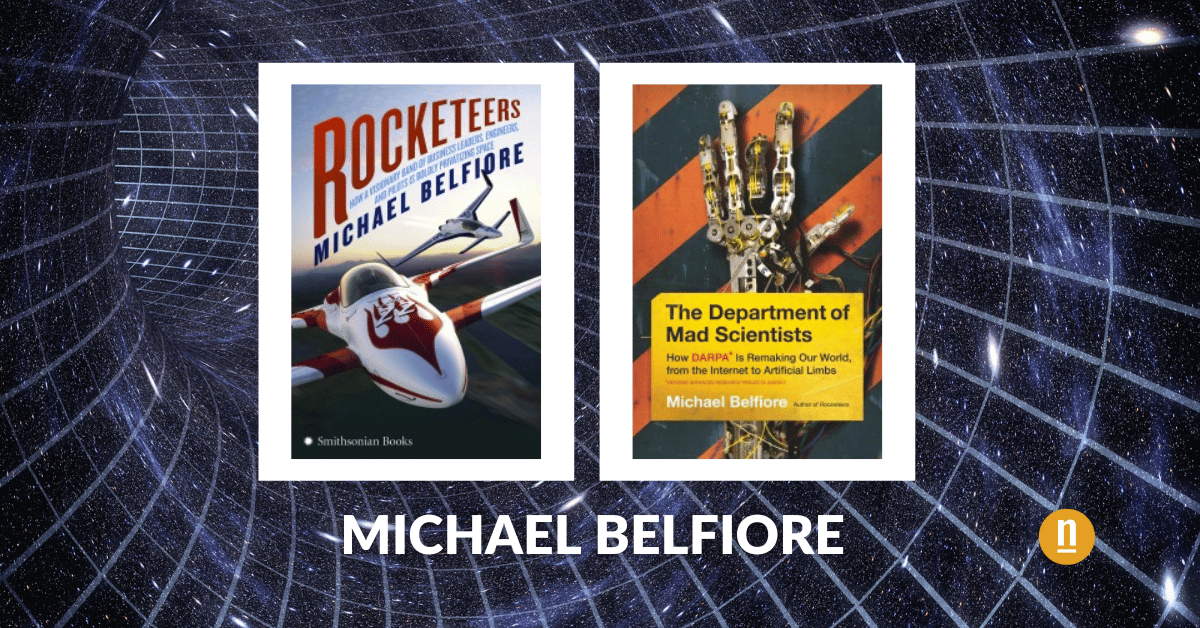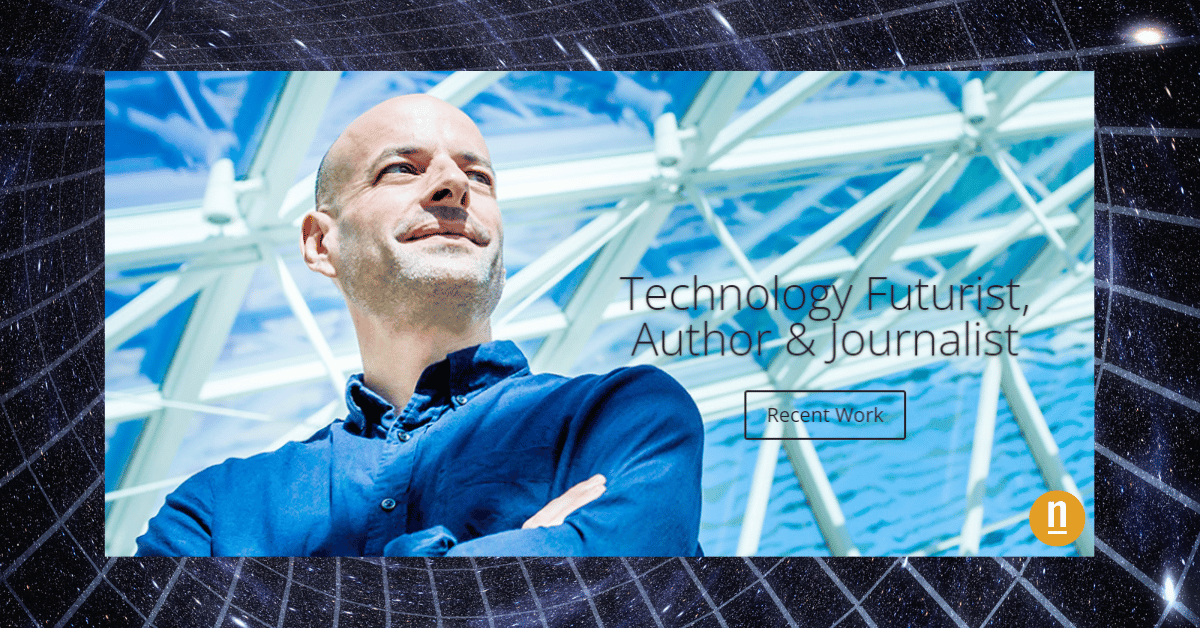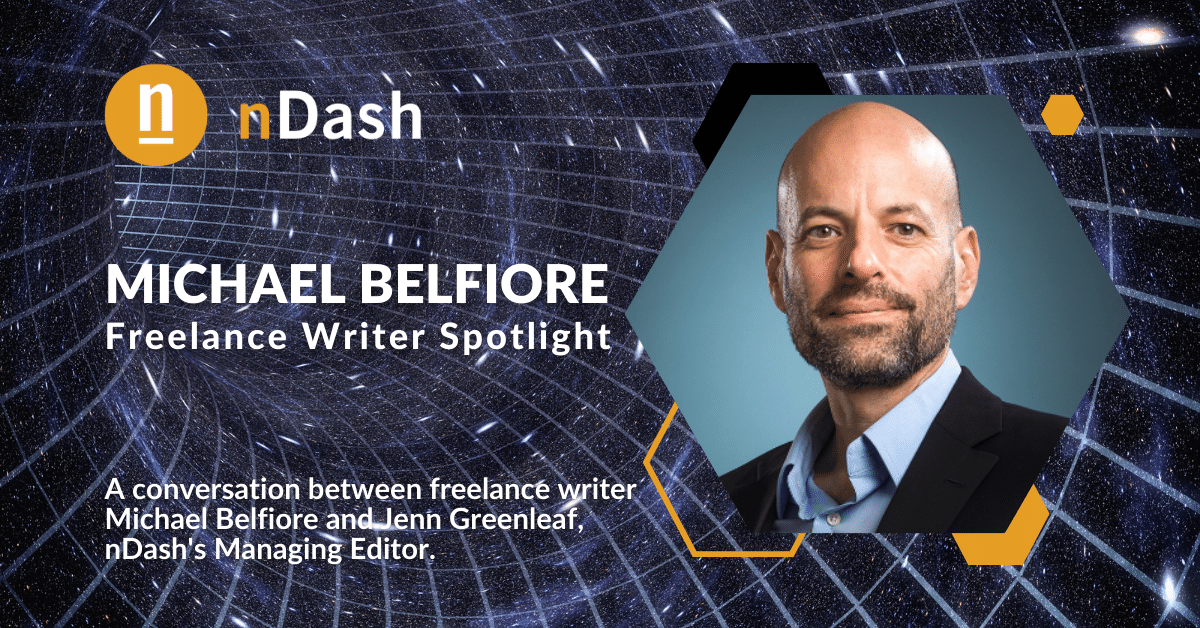nDash’s Managing Editor, Jenn Greenleaf, talks to freelance writer Michael Belfiore about his background as a tech writer and author.
Background: The Highlights
Michael Belfiore began his full-time writing career in Minneapolis in 1995, where he authored software manuals for Target, local utilities, and state and local governments. After relocating to New York City in 1998, Belfiore became a technology-focused business writer for Morgan Stanley and various technology startups.
In 2003, Belfiore’s coverage of SpaceShipOne, a privately-built spacecraft, for the New York Post and Reuters launched his career as a writer focused on innovative technology. Since then, he has contributed articles on spaceflight and cutting-edge technology to prominent publications such as Popular Science, Popular Mechanics, National Geographic, The New York Times, Financial Times, and Bloomberg Businessweek.

Belfiore’s debut book, Rocketeers, was published by HarperCollins in 2008, detailing the establishment of the commercial space age, including the founding of SpaceX. His second book, The Department of Mad Scientists, published in 2009, offers an insider’s perspective on the Defense Advanced Research Projects Agency (DARPA), the Pentagon agency responsible for groundbreaking technologies such as satellite positioning systems, stealth aircraft, and the internet.
Currently, Belfiore creates branded content for prominent technology firms like Google, Microsoft, and Leidos, as well as publishers like The Economist, Vox, and CNN. When not working, he spends time with his two daughters, works on his time travel novel, and learns to play the guitar.
Michael’s Journey as a Freelance Writer

Jenn: Your LinkedIn profile mentions launching your career as a software manual writer. Then, following that, you transitioned into business writing with a technology focus. What sparked your interest in being a tech writer?
Michael: Before tech writing, I wrote science fiction, even selling a few short stories. During that time, a writing instructor at The Loft Literary Center in Minneapolis turned me on to technical writing as a career. I jumped in with a local agency that matched me with some great clients and was hooked.
Even earlier, I got excited about writing when my dad, himself a writer, taught me to read before I entered school. A bit later, when I was six years old, I discovered Rocket Ship Galileo by Robert A. Heinlein in my local public library. I selected it because it was in the grownup section but had pictures, including an illustration of astronauts floating in front of a control panel looking out a window at planet Earth. I still get echoes of the excitement I felt when learning and writing about technology today.
Jenn: Your background in being a freelance writer covering breakthrough technologies is interesting. Was SpaceShipOne the catalyst for this transition from business writing to journalism? Or, was journalism always a part of your career?
Michael: Yes, absolutely. SpaceShipOne lit a fire under me to be part of the action in some way. I had a very clear thought that if I could be on the ground for that first private space shot, I could launch a career as a journalist, specifically one covering emerging technology like commercial spaceflight.
Jenn: Was it challenging breaking into these markets (Popular Science, Popular Mechanics, National Geographic, etc.)?
Michael: True to my dream, SpaceShipOne was my ticket. First, I landed what turned out to be just a paragraph in the travel section of the New York Post and a feature in my local news and arts magazine, Chronogram, to cover the first flight in June 2004. “Totally inappropriate for us,” my editor at Chronogram said. “But this is so cool; we have to do it!” That first launch was a like a space Woodstock. Everyone was there, including my future editor at Popular Science. He gave me my first assignment after SpaceShipOne’s third and final flight in October 2004. The story went on the cover and led to assignments at other magazines as well as more for PopSci and my first book deal.
Jenn: I love that your background includes authoring two books. Can you tell me about your journey from “idea” to publishing with one of the “big five”?
Michael: I had the idea for Rocketeers before SpaceShipOne took off, and I was fortunate enough to have a published friend recommend me to his agent, Linda Loewenthal. Linda liked the idea but said I had no chance without any credits writing about the topic. She intended it as a kindly rejection, but I took it as direction and went about collecting a bunch of bylines before approaching her again. She was very surprised and agreed to take me on as a client, which led to the sale.
Jenn: You’re in the process of preparing a novel for publication. Do you find transitioning from technical writing to creative writing challenging? Can you tell me a little about what inspired this new book?
Michael: I see all of my work as, ultimately, telling a story. There’s something that pulls a reader in, interesting characters, problems to be solved, and ingenious ways of solving those problems. That’s true of blog posts, articles, ebooks, and full-length books, whether nonfiction or fiction.
That said, novel writing is the hardest type of writing I’ve ever done. I’ve written half a dozen novel-length manuscripts, but this is the first one I feel really works as a book. I got the idea when the first Harry Potter novel came out, which tells you how long this thing has been gestating. What intrigued me most about Harry Potter was the hidden train platform that could take you someplace extraordinary. In my book, the hidden platform is at Grand Central. It takes you through time to a secret DARPA project at Edwards Air Force Base, where you can connect to platforms in other eras, including the Cretaceous period—because I just had to have dinosaurs in this book.
Jenn: I see that speaking engagements focusing on your books and space technologies are a big part of your career. Do you feel it’s more challenging to script these talks than it is to write copy?
Michael: For me, speech-writing is a more iterative process. I write a draft, get it in front of an audience, get feedback, and make adjustments for the next engagement. How I tell stories in this format is just as important as what I say. I find I really need audience feedback to bridge the gap because something that looks great on paper may not play as well in spoken delivery.
The Rest of nDash’s Discussion with Michael Belfiore

Michael Belfiore’s background in freelance writing includes covering game-changing technologies. Examples of his bylines include The New York Times and USA Today. His primary focus is providing marketing writing services to technology companies.
Jenn: You and I started working together on nDash around a year after you signed up on the platform. Can you tell me about how nDash became a part of your journey as a freelance writer?
Michael: At that time, I had an intern helping me find new clients. She suggested I put a profile up on nDash, which I hadn’t even heard of until then. It wasn’t long before editors, including you, began reaching out to me, and now it’s a significant source of interesting projects.
Jenn: The freelance writer pitch serves as the backbone of nDash’s platform. As a veteran freelance writer, what percentage of your time do you spend pitching? Do you find that pitching happened more so at the beginning of your career compared to now?
Michael: Joe Haldeman, one of my science fiction writer heroes, told my class at the Clarion West Writers Workshop that he spends as much time on the business of writing as on writing itself. At the time, I thought that sounded nuts and not something I wanted any part of. Today, I spend, yep, at least 50% of my working hours on the business side of things, and that includes pitching, which I set aside time for at least twice a week. These days, I’m mostly pitching brands on my services rather than individual story ideas, and I’ve found ways to enjoy it, mainly by finding common ground with potential clients.
Jenn: What advice do you have for other freelance writers who might be challenged with breaking into new markets or publications?
Michael: This is said so often it’s become a cliche, but I really believe it’s the best advice: do what you love. That means writing about things you’re excited about. For me, it’s technology and how it can help make the world a better place. When you approach editors with that enthusiasm, it can’t help but be infectious, and it opens doors. People love to hear that you want the gig, even if you don’t check every box on a list of qualifications.
Jenn: Where do you see yourself in five years? Do you think you’ll still be focusing on tech topics, or do you think you’ll dive deeper into creative writing?
Michael: Yes. 😊 I’m starting to think about my legacy. I want to leave behind a content marketing writing business that generates reliable revenue with or without me and a shelf of cool science fiction novels. I’m working on building both.
Thank you for talking to me about your background as a freelance writer, Michael!
Work with Michael Belfiore on nDash!
Do you have a project that aligns with Michael’s technical writing background? Check out his freelance writer profile to learn more about how his expertise can level up your content strategy: Michael Belfiore.

